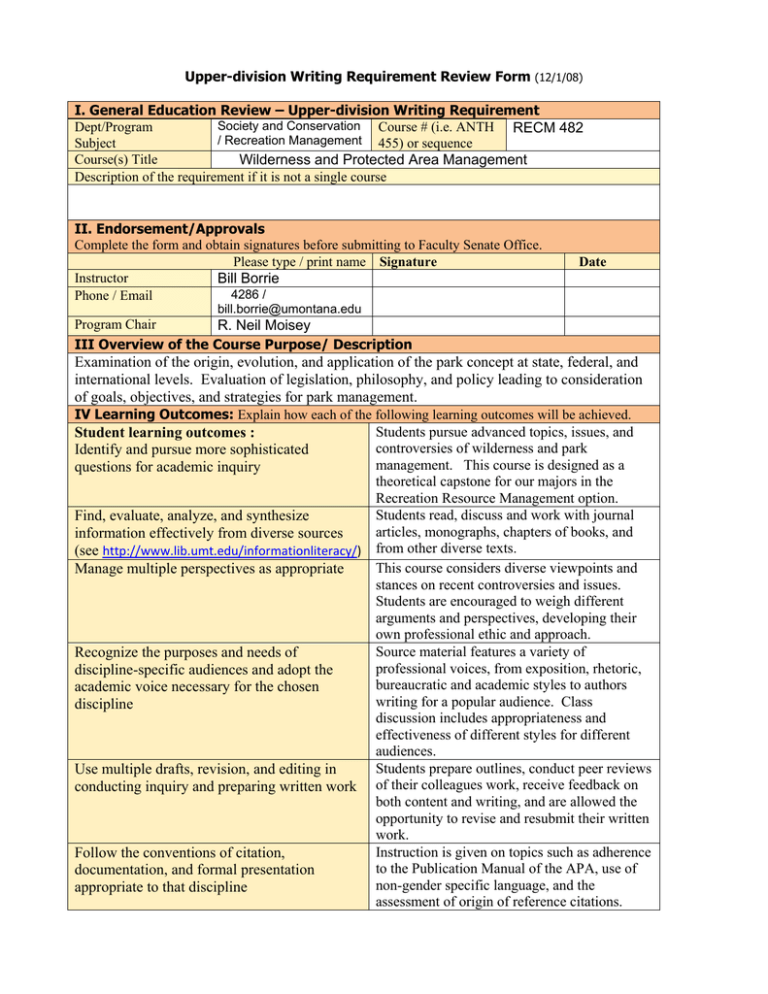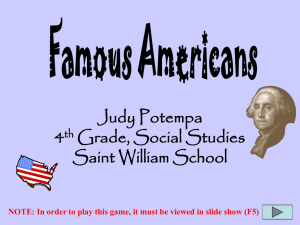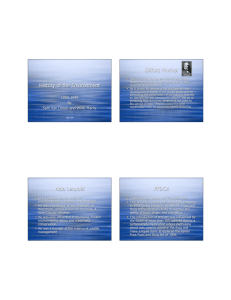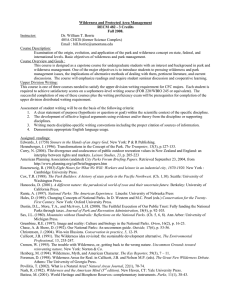Document 11902965
advertisement

Upper-division Writing Requirement Review Form (12/1/08) I. General Education Review – Upper-division Writing Requirement Society and Conservation Course # (i.e. ANTH RECM 482 Dept/Program / Recreation Management 455) or sequence Subject Course(s) Title Wilderness and Protected Area Management Description of the requirement if it is not a single course II. Endorsement/Approvals Complete the form and obtain signatures before submitting to Faculty Senate Office. Please type / print name Signature Instructor Bill Borrie 4286 / Phone / Email Date bill.borrie@umontana.edu Program Chair R. Neil Moisey III Overview of the Course Purpose/ Description Examination of the origin, evolution, and application of the park concept at state, federal, and international levels. Evaluation of legislation, philosophy, and policy leading to consideration of goals, objectives, and strategies for park management. IV Learning Outcomes: Explain how each of the following learning outcomes will be achieved. Students pursue advanced topics, issues, and Student learning outcomes : controversies of wilderness and park Identify and pursue more sophisticated management. This course is designed as a questions for academic inquiry theoretical capstone for our majors in the Recreation Resource Management option. Students read, discuss and work with journal Find, evaluate, analyze, and synthesize articles, monographs, chapters of books, and information effectively from diverse sources (see http://www.lib.umt.edu/informationliteracy/) from other diverse texts. This course considers diverse viewpoints and Manage multiple perspectives as appropriate stances on recent controversies and issues. Students are encouraged to weigh different arguments and perspectives, developing their own professional ethic and approach. Source material features a variety of Recognize the purposes and needs of professional voices, from exposition, rhetoric, discipline-specific audiences and adopt the bureaucratic and academic styles to authors academic voice necessary for the chosen writing for a popular audience. Class discipline discussion includes appropriateness and effectiveness of different styles for different audiences. Students prepare outlines, conduct peer reviews Use multiple drafts, revision, and editing in conducting inquiry and preparing written work of their colleagues work, receive feedback on both content and writing, and are allowed the opportunity to revise and resubmit their written work. Instruction is given on topics such as adherence Follow the conventions of citation, to the Publication Manual of the APA, use of documentation, and formal presentation non-gender specific language, and the appropriate to that discipline assessment of origin of reference citations. Develop competence in information technology and digital literacy Not applicable. V. Writing Course Requirements Check list Is enrollment capped at 25 students? If not, list maximum course enrollment. Explain how outcomes will be adequately met for this number of students. Justify the request for variance. Yes √ No We have not had enrollment over 25 in this course for many years, but have and would employ a graduate TA to help instruct and grade were this to be the case. Are outcomes listed in the course syllabus? If not, how will students be informed of course expectations? √ Yes No Are detailed requirements for all written assignments including criteria for evaluation in the course syllabus? If not how and when will students be informed of written assignments? Briefly explain how students are provided with tools and strategies for effective writing and editing in the major. Will written assignments include an opportunity for revision? If not, then explain how students will receive and use feedback to improve their writing ability. √ Yes No Students are instructed in the value and use of outlines, peer reviews, and editing of examination answers. √ Yes No The final exam includes the opportunity to revise and resubmit answers from their mid-term exam, based on special feedback on both content, organization, and writing skills. Are expectations for Information Literacy listed in Yes √ No the course syllabus? If not, how will students be Students primarily work with written texts informed of course expectations? provided in course packet. Little IT literacy is required beyond professional presentation of their written work. VI. Writing Assignments: Please describe course assignments. Students should be required to individually compose at least 20 pages of writing for assessment. At least 50% of the course grade should be based on students’ performance on writing assignments. Clear expression, quality, and accuracy of content are considered an integral part of the grade on any writing assignment. Mid-term exam (10 pages of writing, 40% of Formal Graded Assignments course grade), Final exam (20 pages of writing, 50% of course grade). Class preparation and participation (10% of Informal Ungraded Assignments course grade). VII. Syllabus: Paste syllabus below or attach and send digital copy with form. ⇓ The syllabus should clearly describe how the above criteria are satisfied. For assistance on syllabus preparation see: http://teaching.berkeley.edu/bgd/syllabus.html Paste syllabus here. Instructor: Wilderness and Protected Area Management RECM 482 - 3 Credits Fall 2008. Dr. William T. Borrie 405A CHCB (former Science Complex) Email : bill.borrie@umontana.edu Course Description: Examination of the origin, evolution, and application of the park and wilderness concept on state, federal, and international levels. Basic objectives of wilderness and park management. Course Overview and Goals : This course is designed as a capstone course for undergraduate students with an interest and background in park and wilderness management. One of the major objectives is to introduce students to pressing wilderness and park management issues, the implications of alternative methods of dealing with them, pertinent literature, and current discussions. The course will emphasize readings and require student seminar discussion and cooperative learning. Assigned readings: Edwards, J. (1758) Sinners in the Hands of an Angry God. New York: P & R Publishing. Henneberger, J. (1996). Transformations in the Concept of the Park. The Trumpeter, 13(3), p.127-133. Curry, N. (2004). The divergence and coalescence of public outdoor recreation values in New Zealand and England: an interplay between rights and markets. Leisure Studies, 23, p. 205-223 American Planning Association (undated) City Parks Forum Briefing Papers. Retrieved September 23, 2004, from http://www.planning.org/cpf/briefingpapers.htm Rosenzweig, R. (1983) Eight Hours for What We Will: Workers and leisure in an industrial city, 1870-1920. New York : Cambridge University Press. Cox, T.R. (1988). The Park Builders: A history of state parks in the Pacific Northwest. (Ch. 1,10). Seattle: University of Washington Press. Hancocks, D. (2001). A different nature: the paradoxical world of zoos and their uncertain future. Berkeley: University of California Press. Runte, A. (1997). National Parks: The American Experience. Lincoln: University of Nebraska Press Hales, D. (1989). Changing Concepts of National Parks. In D. Western and M.C. Pearl (eds.) Conservation for the TwentyFirst Century. New York: Oxford University Press. Dustin, D.L., More, T.A., and McAvoy, L.H. (2000). The Faithful Execution of Our Public Trust: Fully funding the National Parks through taxes. Journal of Park and Recreation Administration, 18(4), p. 92-103. Sax, J.L. (1980). Mountains without Handrails: Reflections on the National Parks. (Ch. 5, 6, 8). Ann Arbor: University of Michigan Press. Grumbine, R.E. (1997). Image and reality: Culture and biology in the National Parks. Orion, 16(2), p. 16-23. Chase, A. & Shore, D. (1992). Our National Parks: An uncommon guide. Outside, 17(6), p. 53-56. Christensen, J. (2004). Win-win Illusions. Conservation in practice, 5, 12-19. Callicott, J.B. (1991). The Wilderness idea revisited: the sustainable development alternative. The Environmental Professional, 13, 235-247. Cronon, W. (1995). The trouble with Wilderness, or, getting back to the wrong nature. Uncommon Ground: toward reinventing nature. New York: Norton & Co. Henberg, M. (1994). Wilderness, Myth, and American Character. The Key Reporter, 59(3), 7 – 11. Foreman, D. (1998). Wilderness Areas for Real. in Callicott, J.B. and Nelson M.P. (eds). The Great New Wilderness Debate. Athens: The University of Georgia Press. Povilitis, T. (2002). What is a Natural Area? Natural Areas Journal, 22(1), 70-74. Nash, R. (1982). Wilderness and the American Mind (3rd edition). New Haven, CT: Yale University Press. Batisse, M. (2001). World Heritage and Biosphere Reserves: complementary instruments. Parks, 11(1), 38-43. Figgis, P. (2003) The Changing Face of Nature Conservation: Reflections on the Australian Experience. In W.M. Adams & M. Mulligan (ed). Decolonizing Nature: Strategies for Conservation in a Post-Colonial Era. London: Earthscan Publications. Bayet, F. (1994). Overturning the Doctrine: indigenous people and wilderness- being Aboriginal in the Environmental Movement. Social Alternatives, 13(2), 27-32. Palmer, L. (2004). Bushwalking in Kakadu: a study of cultural borderlands. Social & Cultural Geography, 5, 109-127. Langewiesche, W. (1999). Eden: A gated community. Atlantic Monthly, 283(6), p. 84-105. Crowe, D.M. & Shryer, J. (undated). Eco-colonialism: an opinion from sub-Saharan Africa. Available: http://www.allianceforamerica.org/1196010.htm Snyder, G. (1990). The Etiquette of Freedom. The Practice of the Wild. New York: North Point Press. Turner, J. (1996). Interview. Wild Duck Review, 2(6), 8 – 11 and 3(1), 3-4. Assignments: 1. The course will operate as a student-centered seminar. The instructor will provide introductions to the course and to particular topics, and will also provide additional substantive material as appropriate. Students are expected to be prepared to discuss the assigned material in detail. An important component of your evaluation will be the quality of your daily preparation and participation. 2. The mid-term and final exam will be of a comprehensive nature, covering all of the course readings, lectures, discussions and field trips. They will be taken in the form of take-home examinations, and will comprising 2 – 4 questions, each around 4 – 5 pages long. You will be given the opportunity to consider feedback, revise and resubmit your mid-term responses as part of the final. The mid-term will be graded for content, as well as the quality of writing, using the following breakdown : 40 % Writing Skills 13% Clear and correct communication (Expression, Grammar, Spelling, & Referencing) 13% Organization and Review (Attach outline and peer review of your answers) 13% Coherent and well-structured arguments (Logical progression, flow, arguments backed with evidence) 60% Content 30% Coverage of topic (including adequate length) 30% Ability to use quotes from readings Table 1. Grading distribution for RECM 482. Fall 2008. Total Mid-term exam 40 Final exam 50 Class participation 10 100 Policies : 1. Any student with learning disabilities or disadvantages needing special dispensation or assistance will inform the instructor immediately following the first class. 2. It is expected that all work tended for evaluation will be professionally presented. Written submissions should be typed (preferably laser printed or high quality dot matrix). Proof-read and spell-check your documents. Folks reading your work assume you mean to present it the way that you do. 3. Late submissions are not encouraged. A standard policy of subtracting 10% per day (or part day) late is fair to everyone (students, instructors, and administration). Extraordinary circumstances (such as a death in the family) should be discussed with the instructor in advance. Leave from college due to medical conditions can be documented with doctor’s certificates. Otherwise special dispensation involves discussion with the Department Chair, Mike Patterson. Seek assistance before problems or difficulties get too major! 4. Attendance is expected, though not required for all classes. It is the student’s responsibility to arrange in advance so as to absolutely minimize the disruption on other students, and to make up, through alternative learning activities, the material missed due to absence. We’re all in this together - don’t get behind! 5. All course activities are governed by the Student Conduct Code, which embodies the ideals of academic honesty, integrity, human rights, and responsible citizenship. We can assume these things, right? Table 2. Proposed Course Schedule: RECM 482. Fall 2008 Day Topics Readings (before this class) Tues, August 26 Parks & Protected Areas – naturalness? Edwards Thurs, August 28 Parks & Protected Areas – sacred & profane? Henneberger Monday, Sept. 1 > Tues, Sept. 2 Parks & Protected Areas – recreation? Curry Thurs, Sept. 4 City Parks – economic development? City Parks Forum Briefing Papers Tues, Sept. 9 City Parks – social control & social justice? Rosenzweig Thurs, Sept. 11 State Parks – progressivism & access? Cox Tues, Sept. 16 Zoological Parks – nature’s diplomats? Hancocks Thurs, Sept. 18 National Parks – nationalism? Runte Tues, Sept. 23 National Parks – democracy? Dustin, More & McAvoy Thurs, Sept. 25 National Parks – reflective recreation? Sax Tues, Sept. 30 National Parks – vignettes of primitive America? Grumbine; Chase & Shore (Christensen) Labor Day Holiday MID-TERM HANDED OUT Thurs, Oct. 2 - Mid-term due: Tuesday, Oct. 7, 9:30am Tues, Oct. 7 Wilderness – the attack (I) Callicott Thurs, Oct. 9 Wilderness – the attack (II) Cronon Tues, Oct. 14 Wilderness – the defense (I) Henberg; Thurs, Oct. 16 Wilderness – the defense (II) Foreman; Povilitis Tues, Oct. 21 International Protected Areas – for whom? Nash; Batisse; Thurs, Oct. 23 International Protected Areas – different models? Figgis Tues, Oct. 28 The Ethnocentric critique – indigenous views (I) Bayet Thurs, Oct. 30 The Ethnocentric critique – indigenous views (II) Palmer Tues, Nov. 4 > VOTE! Thurs, Nov. 6 Private Protected Areas? Tues, Nov. 11 > Thurs, Nov. 13 Eco-colonialism Crowe & Shryer Tues, Nov. 18 Wildness Snyder Thurs, Nov. 20 Wild & Free Turner Tues, Nov. 25 Catch-up Day Thurs, Nov. 27 > Election Day Holiday Langewiesche Veterans Day Holiday Thanksgiving Vacation Tues, Dec. 2 FINAL EXAM HANDED OUT Final exam due: Wed, Dec. 10, 10.10am Wilderness and Protected Area Management RECM 482- 3 Credits Take-Home Final Exam 2008 Due : Wednesday, December 10 – 10.10am Answer four of these questions. Please separate and label your answers with the number of the question you are answering. No more than five typed pages per question. Make sure you answer all parts of the questions. Make extra effort to quote from the textbooks and any other source materials you consider relevant, but make sure you reference other author’s ideas appropriately. I recommend the referencing style of the Publication Manual of the APA (4th Edition). • You must work independently of other students and their answers to these questions. The grading for each question will be along the following lines: Content 30 % Writing Skills, 70% 1. Alston Chase says that “Natural regulation requires superintendents to sustain the semblance of wilderness by treating these places as though they really were wilderness, merely needing to be left alone” (1992, p. 54). Why isn’t merely leaving wilderness alone (passive management) sufficient? Explain how the alternative (active management) is also problematic. Why does Chase say that “the parks’ greatest enemy is their own mythology” (1992, p.54)? 2. Donald Waller (1998) describes Bill Cronon’s attack on wilderness. Cronon, he says, argues “that our ideas about wilderness are so culturally and historically mired as to have become an albatross around the neck of contemporary conservationists”. Do you agree? Lay out Cronon’s and Callicott’s critique of the wilderness idea, and then present a defense of the wilderness idea in rebuttal. (You should include discussion of the ‘character thesis’). 3. Figgis (2003) suggests a need for new models for protected area management, in contrast to the “Western model of defined boundaries, legislative status, public ownership, and exclusion of human commerce” (p. 199). Explain why there might be the need for new models, and discuss the alternatives such as “bioregional models, Indigenous Protected Areas, large private reserves and fenced wildlife sanctuaries” (p. 203). 4. Crowe & Shryer (1995) suggest that western conservation groups in their efforts to save African biodiversity act in a type of post-modern ecological colonization. In what ways might eco-colonialists be similar to the colonial behavior of the British in Australia? What sorts of responses might foreign conservationists expect from local and indigenous groups? What is the fundamental tension between the objectives, values, and approaches of these two groups (international protected areas, and local/indigenous groups)? How might that fundamental tension be successfully negotiated? (Give specific examples or recommendations) 5. If “wilderness is a place where the wild potential is fully expressed” (Snyder, 1990, p. 12), should wilderness be managed for wildness? Jack Turner suggests that the notion of “managed wildlands” is an oxymoron, and that conservation biologists (ecological restorationists) use science to manage nature in destructive ways (Turner, 1996, p. 9). Why does he believe this? What’s wrong with zoos and botanical gardens? What is wildness, and why is it important? 6. A commercial ski resort is proposed for the interior slopes of Yellowstone National Park. Discuss why this would or would not be an appropriate use of the park / defacto wilderness area. Make explicit mention of the values of the National Park, and what National Parks and wilderness areas are for. Explain which sort of recreational experiences should be preferred in National Parks, and how and why park managers might achieve that preferencing (eg. Sax suggests prioritizing reflective recreation).





